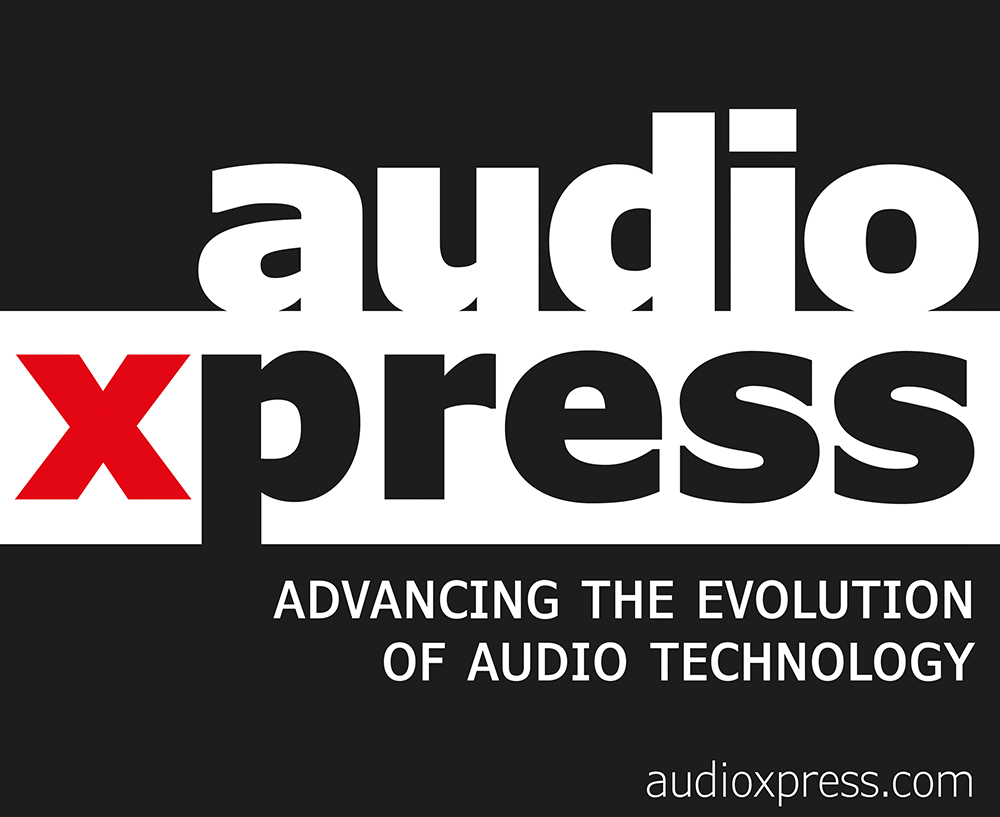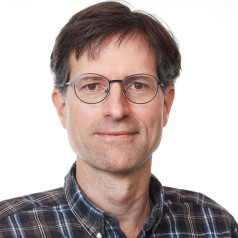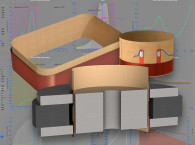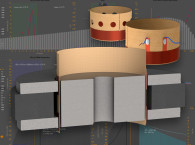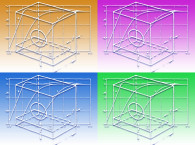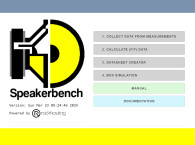
Before the pioneering work of Neville Thiele, Richard Small, and their predecessors, box design and tuning were matters of trial and error. The introduction of speaker responses derived from classical high-pass filters such as Butterworth, Chebyshev, and Bessel were a quantum leap forward. This concept was referred to as “alignments” since the response was aligned to match a classical filter response. This was followed by new classes of generalized alignments such as QB3 and SC4. The tuning parameters are found in tables in cookbooks and embedded in box simulators. See Claus Futtrup’s “Loudspeaker Bass Reflex Alignments” article [1] for more historic details.
However, this profound insight seems to have been gradually forgotten and the trial and error crept back again—now in the form of twiddling knobs in a box simulator program. One reason may be that none of the classical alignments give a desirable almost flat response with good extension for modern low Qts drivers. Another reason is that passive radiator (PR) box types have become increasingly popular since it allows compact boxes to go deep. Unfortunately, there are few textbook alignments for PR box types from which to choose.
The historic work on speaker box alignments has been deeply rooted in analytic solutions. This paper explores numerical optimization to synthesize attractive alignments both for reflex and passive radiator box types.
Modeling Reflex
Bass reflex models as a fourth-order high-pass filter and has generally 4 degrees of freedom: frequency and Q for two sets of generally complex poles. Seen from the box design side, these 4 degrees of freedom typically chosen as the driver free field resonance fs and its total quality factor Qts, the so-called tuning ratio h=fb/fs where fb is the port frequency and, finally, the volume ratio α=Vas/Vbox where Vas is the equivalent air volume of the driver suspension. Since the possible responses all scale in frequency by the driver fs, we can normalize the frequency response by fs, which cuts one degree of freedom.
Three dimensions is still a vast space to search for suitable alignments—especially using trial and error. Luckily, the classical filter types can be used and mapped back to the box parameters. This means that any fourth-order high-pass filter can be mapped into the (fs, Qts, h, α) design space. The most known filter type is the Butterworth filter, which features the flattest amplitude response possible. This is a so-called point-tuning that only exists for one set of parameters: Qts needs to be exactly 0.3827 (assuming no box losses). Another well-known filter is the Bessel filter, which has the flattest possible group delay at the expense of a somewhat more drooping bass roll off. Again, this only exists as a single point in the design space where Qts=0.3162.
We see that the driver Qts is critical since it defines the dominant damping in the system (i.e., the losses from the suspension and the electrical damping). To accommodate a wider range of Qts values there is the QB3 alignment, which is maximally flat for a given Qts value. QB3 is thus useful for drivers with Qts lower than 0.3827 (what is required for Butterworth). For Qts above that we have the Chebyshev fourth-order filters that provide equi-ripple approximations to a flat passband. Here the passband magnitude is no longer monotonic but is allowed to ripple within a specified ripple band. This allows more bass extension than for Butterworth at the expense of a rippling and non-monotonic magnitude response.
All these alignments are found in the literature as tuning tables [2] specifying α and h for a range of Qts values (i.e., they represent curves rather than single points in the design space). These tables also list the obtained normalized -3dB bass corner frequency F3/fs. Generally, as Qts is below the Butterworth point (Qts=0.3827), we get less bass extension, and need a smaller box volume and, conversely, we get more bass extension, but sharper roll off and need a larger box as we go higher in Qts. The mathematics behind the C4 alignments can be extended for lower Qts values than the Butterworth point and this is called SC4 (Sub Chebyshev). Similarly, QB3 is extended above the Butterworth point as SQB3.
Time-Domain vs. Frequency Domain vs. Phase Domain
The time-domain behavior (i.e., the impulse response) is mathematically linked to the frequency domain (i.e., frequency response). Moreover, all the possible box alignments are minimum phase, which means that there is a further mathematical link between the magnitude response and phase response. Once the magnitude response is known, then the phase response and impulse response is uniquely identified.
Bode’s Forgotten Gain-Phase Relation
The mathematical link between gain and phase of a minimum phase response can be expressed in many ways. The commonly known link is that the phase is the Hilbert transform of the logarithm of the magnitude response. However, the Hilbert Transform is hard to comprehend intuitively, and the formulation is in the linear frequency domain. Less known is the Bode’s Gain-Phase Relation [3], which is attractively formulated in the log-magnitude/log frequency domain, which is how we generally plot speaker and filter responses. The Bode Gain Phase Relation states that the phase as the slope of the magnitude vs. frequency response in log-log plot and then smoothed by a specific kernel being the hyperbolic cotangent function coth(x).This gives the intuitively known fact that for each order magnitude response slope (6dB/octave) is increased, the phase increases by 90 degrees.
For example, a second-order low-pass filter has an asymptotic phase of 180 degrees in the stop band and 0 degrees in the passband. Bode’s Gain-Phase Relation states in other words that a flat speaker magnitude response in the passband also secures a near-zero phase and thereby also near-zero group delay. However, the group delay and phase can be very high around the response corner frequency, and due to the smoothing kernel, the phase only approaches zero at frequencies is well above the corner frequency even if the passband gain is completely flat.
Traditionally, the B4 and the Bessel type responses are considered better in the time domain compared to the C4 responses due to less ringing (or rather faster decaying ringing). However, as we shall see, the counterintuitive fact thanks to the Bode Gain Phase Relation, is that the group delay of a C4 response is lower than for B4 and Bessel from around the corner frequency and up. This is simply due to the C4 response magnitude staying flatter deeper down whereas B4 and Bessel magnitudes are drooping. Mathematically, the group delay is the delay of the envelope of a tone burst and too much may give the impression of a sluggish and “slow” bass. However, the audibility of group delay is somewhat controversial.
Let’s compare alignments for a driver with a given resonance frequency fs. We adjust its Qts upward (e.g., by adding a series resistor) and box volume and port tuning to obtain three text book alignments, namely Bessel (Qts=0.3162), Butterworth (Qts=0.3827), and Chebyshev with 0.5dB ripple (Qts=0.55). The magnitude and group delay responses are shown in Figure 1, where the frequency axis is normalized to the driver fs.

We note that the somewhat surprising result is that C4 has the lowest group delay from around 0.9fs and up. Moreover, it has the deepest bass extension with a 3dB corner at 0.6fs, which is more than an octave deeper than for the Bessel alignment. However, the group delay of the C4 explodes around its corner frequency whereas the Bessel response has an almost constant and low group delay below its corner frequency.
The mathematical definition of a Bessel filter is having the flattest group delay possible. However, this applies to the low-frequency range and not in the passband where it matters the most (here we have the program material signal energy to which we want to listen). The Bessel response further suffers from a drooping bass roll with a 3dB corner at about 1.5fs. Consequently, at around fs the Bessel response is about 8dB down in magnitude and has more group delay than the C4 alignment. This means the flat and extended magnitude response of the C4 is attractive, if there is no or little signal content at the corner frequency or below where the group delay rises significantly.
In all fairness, the box volumes of the three examples vary drastically: At one extreme, the Bessel uses a small box volume of Vas/2.45 (α=2.45) followed by the B4 at Vas/1.41 and very large at Vas/0.49 for the C4. However, this is simply dictated by Hofmann’s infamous Iron Law: a passive speaker that goes deeper for the same sensitivity needs a larger box.
Numerical Optimization—Problem Statement
The question is if we can find alignments with similar equi-ripple responses such as Chebyshev that extend deep but exist for a range of lower Qts values than for C4? For Qts below 0.38 we only have QB3 and SC4 to choose from among the classical alignments and they all have rather drooping bass responses, which results in higher group delay above the corner frequency. As the comparison example between C4, B4, and Bessel showed: Having a flat equi-ripple magnitude response secures that the group delay is low at frequencies above the corner frequency.
The aim of this article is to explore alignments that has equi-ripple responses but that unlike C4 work for a whole range of Qts values including even very low values. While the classical alignments are derived analytically through beautiful math, we will here simply use numerical optimization and benefit from the huge CPU power available nowadays compared to the early 1970s where many of the landmark papers by Thiele and Small were published. Some earlier work on numerical optimization exists in the literature [4].
By letting an optimization algorithm search the parameter space we can obtain interesting alignments that are not derived from classical filter types. Such free-form optimization is controlled by an object function to be minimized and optional subject to meeting certain constraints. A further objective is to optimize alignments for PR boxes based on the exact same criteria as used for reflex.
Definition of Quasi-Chebyshev Alignments—The Filter Approximation Perspective
The different classical alignments can all be seen as approximations to an ideal high-pass filter. These approximations have different properties. For the Butterworth, the magnitude error drops maximally fast with the frequency (i.e., the error for the B4 alignment is proportional to f-4). This means that the magnitude error becomes vanishingly small as we move a couple of octaves above the corner frequency. Conversely, the magnitude loss is rather high, being 3dB down at the corner frequency.
The C4 alignment is based on a different approximation criterium where the maximal deviation from a constant magnitude is minimized. Such approximations are called equi-ripple or Minimax. Here, the magnitude error is prescribed to stay within a certain ripple band. This allows a smaller maximal deviation compared to Butterworth but at the expense of a rippling and non-monotonic magnitude response. Both Chebyshev and Butterworth are optimal but based on different optimality criteria.
The Chebyshev Alignments for Reflex C4
The C4 alignment has a passband magnitude response staying inside a ripple band of width Rp decibels. For example, a 1dB C4 response has a passband where the magnitude stays constant within 1dB from the passband edge fp to infinite frequency. The C4 alignment is the optimal, in the sense that it’s the response with the widest possible passband (i.e., lowest possible corner frequency fp) that meets the ripple band criterion.
According to the function approximation theory [5], the optimal response is prescribed to hit the ripple band edges at exactly N+1 points where N is the filter order: For the C4 reflex response these points are: lower ripple band limit at the passband edge fp, the upper ripple band edge at a local maximum followed by the lower ripple band edge at a local minimum, then the upper edge at a next local maximum and asymptotically hitting the lower edge at infinite frequency. This can be shown graphically in Figure 2.

The Quasi-Cheby (QC) Alignment
We will generalize the C4 alignment to have more freedom to secure existence of solutions with a wide range of Qts values. This is like the QB3 alignments that are a relaxed version of the fourth-order Butterworth point solution B4, where the magnitude response is allowed to be flat to a lower order than for the B4. While B4 is flat to fourth order the QB3 is only flat to a lower order, and this allows the freedom to exist for a range of Qts values. Similarly, we will relax the equi-ripple constraint known from the Chebyshev alignment to allow more freedom in choosing Qts.
We again let the global magnitude maximum define the top of the ripple band of height Rp[dB]. The magnitude enters the ripple band first at the passband edge fp and above the magnitude response stays within the ripple band until infinite frequency. This is so far fully in compliance with a Chebyshev type 1 filter. However, we do not constrain the magnitude response to hit the ripple band edges at any point other than at the global maximum and the passband edge fp thus allowing 3 degrees of freedom for a fourth-order reflex response. We can illustrate this graphically in Figure 3.

This is the most relaxed way to specify an almost flat filter with the widest passband. The ripple band is free to move relative to the asymptotic high-frequency gain and the response does not necessarily hit the ripple band edges except for at fp and the maximum. The extra degrees of freedom in the presented formulation allows the optimization to find better responses and allow Qts to be specified in a range for a given ripple value Rp. One could say that we have generalized the C4 responses since they all meet the criteria described but we include a much larger solution space. The extra freedom also allows for constraining the solution to meet other criteria such as the time-domain behavior or group delay. We name the new responses Quasi-Chebyshev alignments or in short as the QC-alignment.
The typical value of the ripple limit Rp is 0.5dB as we have used in the present article. However, the alignments can be optimized for even small ripple limits such as 0.25dB as well as much larger ripple. We define the 3dB corner frequency F3 from where the gain is 3dB down from the asymptotic high-frequency gain.
Numerical Optimization
The QC alignments are found by numerical solution of the optimization problem: minimize the object function f(x) subject to meeting the constraint g(x)<0. In here x is a vector of the free variables, which for the reflex case is h and α. We repeat the optimization for a range of Qts values to get a tuning table. For each evaluation of f(x) we calculate the magnitude response and find the absolute maximum magnitude. Subtraction of Rp yields the lower edge of the ripple band. Then we find the passband edge fp as the lowest frequency where the magnitude crosses the lower passband edge. The object function f(x) then simply returns fp. The constraint function g(x) checks if the magnitude stays within the ripple band at any frequency above fp. The object and constraint functions were formulated in Matlab and solved using the fmincon() algorithm.
Application of the QC Optimization Criteria to Higher Orders
The QC optimization criteria can be applied to fifth-order PR alignments as well. Moreover, we can apply the QC criteria to much more complex higher-order transfer functions. One example is the so-called assisted alignments where the response has extra filter elements either as extra passive components such as a series capacitor between the amplifier and the driver or an active line level filter prior to the amp. Another example is when the box model is combined with the electrical response of a passive filter and a model of the driver inductance.
Example: QC Alignments for Reflex
A series of basic fourth-order reflex responses were optimized according to the QC criteria. Figure 4 shows the results for a sweep of Qts from 0.2 to 0.55 using a ripple of Rp=0.5dB. Such 0.5dB ripple is in most cases below the anechoic acoustical measurement accuracy at lower frequencies and it is questionable if better than 0.5dB ripple is needed. In addition, we used the box leak loss Ql=15 and no absorption or port loss (to make it compatible with the old popular tuning tables [2]). We normalize the frequency axis to the driver fs, which leaves only α (volume ratio) and h (normalized port tuning frequency) as free parameters for each Qts value.

The graph for Qts=0.2 is highlighted (blue) and has the highest corner frequency fp. All graphs from here and Qts up to 0.5 (highlighted red trace) have a maximum amplitude of 0dB hit just above fp and at infinity. Solutions for Qts above 0.5 have two local maxima above 0dB (i.e., the ripple band shifts upward) until the Chebyshev solution is hit around Qts=0.58 (highlighted light blue trace) above which there are no more QC4 solutions.
The QC4 tuning table is compared to QB3/SQB3 and C4/SC4 in Figure 5. As expected, the new QC4 hits the traces for C4 at the end point Qts=0.58. Below this value, QC4 has the lowest F3 of all the shown alignments.

Example: Reflex Box for PTT6.5X04-NFA-01
We compare the QB3 with the new QC4 for the PTT6.5X04-NFA-01 6.5” woofer with Qts=0.27, Vas=27L. We use the popular VituixCAD enclosure tool and by clicking the align to QB3 we get Vb=6.6 L and fb=42.7Hz when assuming Ql=15 and no other losses. From interpolation in Table 1 we find for the QC4 at Qts=0.27 that α = 2.4 and h=1.27. Interestingly, the port tuning is almost the same (same h) at fb=30Hz∙1.27=42.7Hz, but the QC4 alignment uses a larger box (smaller α) with Vb=27L/2.4=10.7L. The QB3 magnitude has a F3=52.6Hz frequency limit whereas the QC (0.5dB) goes all the way to F3=42.4Hz (Figure 6). The QC response has lower group delay than the QB3 from about 61Hz and up (Figure 7).



Passive Radiator Alignments
When it comes to boxes with PR tuning, there is very little help from the literature. A PR box has a fifth-order transfer function with generally one complex zero (the notch at the free-field resonance of the PR) and three zeros at 0Hz. This means that there are no classical filter prototypes from which we can map. However, PR alignments are in many ways like reflex and is mainly defined by the same 3 degrees of freedom: Driver Qts, volume ratio α, tuning ratio h. We can apply the QC framework for passive radiator box as well. Assuming that two passive radiators are used and that they have the same area Sd, compliance Cms and damping Rms as the active driver. For the box, we again assume the leak loss to be Ql=15 and no other losses.
Instead of controlling the tuning ratio h, we use the mass ratio (MR), which is the ratio of the moving mass of the PR to the Mms of the driver. This is practical since moving mass is a datasheet value and any additional mass plug can be determined easily. Moreover, it turns out that the MR stays surprisingly constant across a wide range of Qts. Again, numerically optimizing for the QC criterion with 0.5dB ripple and assuming having two PRs with the same Sd, Cms, and Rms as the active driver, we get the responses shown in Figure 8 and Table 2. Again, we see that the solutions bifurcate at Qts=0.5, where the peak magnitude and thereby the ripple band shifts above 0dB. Above Qts=0.61 there are no more solutions. The PR alignments have generally less bass extension compared to the reflex alignments for the same Qts.


Conclusion
The QC optimization criterion seems attractive for both reflex and passive radiator boxes. The near flat passband helps keep the group delay low above the corner frequency. The QC criterion can be applied to higher-order assisted alignments, for example, with active or passive filters in front of the driver. An excellent topic for future work. VC
Author Acknowledgement: I am very grateful for the suggestions and insight given by Claus Futtrup.
References
[1] C. Futtrup,“Loudspeaker Bass Reflex Alignments,” audioXpress, June 2024.
[2] V. Dickason, Loudspeaker Design Cookbook, 8th Edition,” KCK Media, 2023.
[3] J. Bechhoefer, “Kramers–Kronig, Bode, and the meaning of zero,” American Journal of Physics, 79 (10), 2011, pp. 1053–1059.
[4] R. Gonzales, “Quasi-Monotonic Vented Alignments,” Speaker Builder, January 1993.
[5] “Approximation theory,” Wikipedia, https://en.wikipedia.org/wiki/Approximation_theory
This article was originally published in Voice Coil, December 2024
